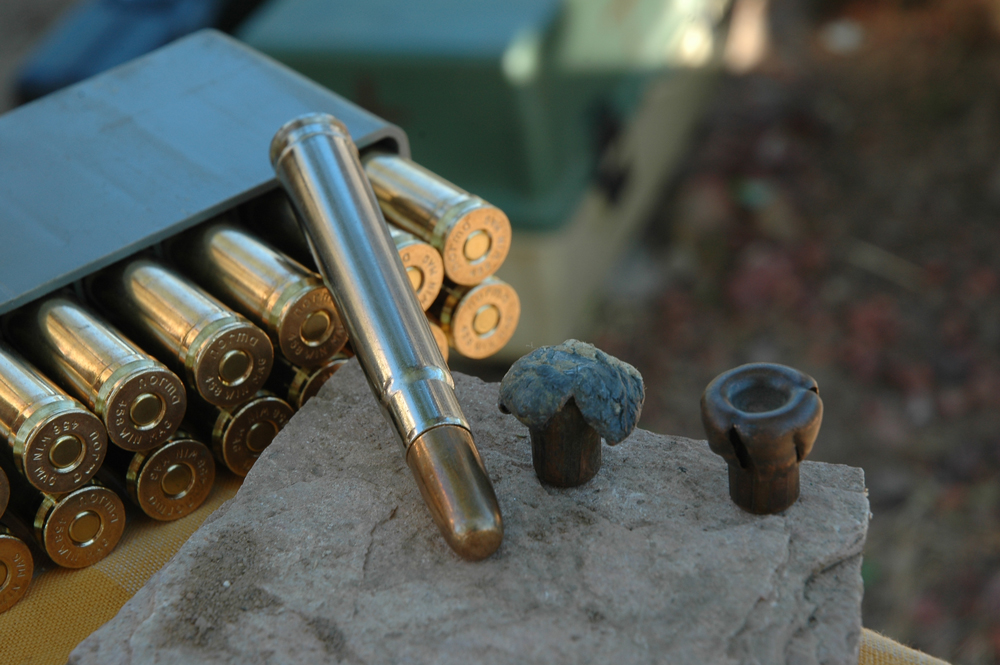At GunDigest, we independently review products. However, we may earn a commission when you purchase through links on our site. Learn More
The Best Rifles are .375s!

Disagree? Few others can boast a century in the greatest game fields!
A hundred years ago, the English gun-making firm of Holland and Holland introduced the .375 Belted Rimless Nitro Express. It arrived Stateside in 1925, when Western Cartridge Company began loading it. As the .375 H&H Magnum, it spawned the .300 H&H Magnum. Around 1926, up-scale New York gun-builder Griffin & Howe began barreling Magnum Mausers to .375.
In 1937 it became a charter chambering in Winchester’s new Model 70. Remington offered the .375 H&H in its 725 Kodiak (though fewer than 100 were built, all in 1961). Actions for the .375 must accommodate its 3.60-inch loaded length. Cases measure 2.85 inches, base to mouth. A rimmed form of the .375, for double rifles, also appeared in 1912: the .375 Flanged Magnum Nitro Express. But the belted round works fine in hinged-breech mechanisms. Steeply tapered, with a shoulder angle of less than 13 degrees, .375 rounds slip eagerly into a double’s open breech, and feed silkily in bolt rifles.
In his book, “African Rifles and Cartridges,” John Taylor praises the .375 H&H: “I’ve had five of these rifles … and have fired more than 5,000 rounds of .375 Magnum ammunition at game…. One [rifle] accounted for more than 100 elephant and some 411 buffalo, besides rhino, lions … Although my formula gives this rifle a Knock-Out value of 40 points, I must regretfully admit that does not really do full justice to it.”
Taylor recalled a buffalo he’d shot with a 300-grain solid from his .375 double. “The bull dropped to the shot but in an instant was up again … I gave him the left barrel fairly in the center of his great chest…. He crashed on his nose [and] keeled over — stone dead.”
With .375s I’ve downed buffalo and elephant. Woodleigh solids, loaded in Norma ammunition, drive deep. At 350 grains, they carry more weight and length than standard 300-grain bullets. The stout Trophy Bonded bullets (Federal) and Swift A-Frames are my pick for softpoints.
In full-throttle loads, they bring two tons of energy to 50 yards. Still, the .375 can be chambered in a rifle as lively as a .30-06. Most hunters can point such a rifle more deftly than they can a heavier if shorter, double. And they can fire it without fear of turning their cheek or shoulder the color of old cheese. Part of the reason the .375 is so popular for dangerous game is that it can be fired accurately by people of average build and shooting experience — in rifles of modest weight.
Quick handling and high magazine capacity make first hits faster, and put more bullets into crippled animals than might be possible with ponderous big-bore rifles. A couple of years ago, I dashed around a bush to the cry of a tracker who’d come suddenly upon the leopard we’d been trailing. My .375 — a Montana Rifles lightweight — came up like a shotgun and all but fired itself. The cat rocketed into the air with broken shoulders. It died as it hit the ground.
My favorite .375s? Certainly that Montana, which has also taken buffalo and eland and a big giraffe — which weighed almost twice as much as a buff! An old Model 70 with Redfield receiver sight downed my first buffalo and still ranks high. Sako’s handsome Kokiak has a nose for the target; its laminated stock is among the most comfortable I’ve used. Remington briefly marketed a Mauser in .375, and I snapped one up. It’s a classic, with features — a positive extractor, dead-certain feeding — that made early .375s so effective.
For decades, the .375 H&H brooked no rivals. In the 1940s Roy Weatherby came up with his own .375 Magnum on the same case, but blown out, with a radiused shoulder. Despite a velocity edge of 200 fps, it couldn’t compete with the Holland round. (Recently it has returned to the Weatherby stable). A few years ago, Hornady trotted out the .375 Ruger. Developed to work in .30-06-length actions, it has roughly 10 percent more capacity than the .375 H&H Magnum, thanks to a wider body with little taper. Its .532 head diameter is the same as that of the .375 H&H; but the .375 Ruger is rimless. It pushes bullets 5 percent faster, from a hull .27 inch shorter.
Still, in every game field worldwide, you’ll find cartridges for your .375 H&H rifle. It may be another century before another .375 can make such a claim!
Next Step: Get your FREE Printable Target Pack
Enhance your shooting precision with our 62 MOA Targets, perfect for rifles and handguns. Crafted in collaboration with Storm Tactical for accuracy and versatility.
Subscribe to the Gun Digest email newsletter and get your downloadable target pack sent straight to your inbox. Stay updated with the latest firearms info in the industry.